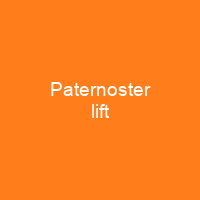A paternoster is a chain of open compartments that move slowly in a loop up and down inside a building without stopping. As of 2015, Germany has 231 paternsters, and 68 in the Czech Republic. Only three have been identified outside Europe: one in Malaysia, one in Sri Lanka, and another in Peru.
About Paternoster lift in brief

The risk involved is estimated to be thirty times higher than conventional elevators. Elderly people, disabled people, and children are the most in danger of being crushed or losing a limb. In 2012, an 81-year-old man was killed when he fell into the shaft of a pateroster in the Dutch city of The Hague. In 2009, Solon received special permission to build a new, fully-controlled elevator doors in its Berlin headquarters. Many examples have been shut down, but there are surviving examples in following locations.
You want to know more about Paternoster lift?
This page is based on the article Paternoster lift published in Wikipedia (as of Jan. 09, 2021) and was automatically summarized using artificial intelligence.







